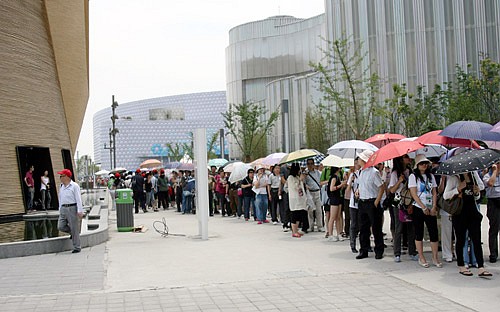|
 |
|
IN GOOD ORDER: Visitors queue at a bus station at the World Expo's Puxi site on June 7. In May, a total of 8 million people visited the World Expo, averaging 500,000 a day (LI BAISHUN) |
The World Expo's operation in the first month was stable and orderly, and things gradually came on to an established track, said Hong Hao, Director of the Bureau of Shanghai World Expo Coordination, at a press conference on June 1.
The logistics, event running, visitor reception and security of the World Expo in Shanghai, which lasts from May 1 to October 31, ran smoothly. There were no serious accidents or food safety incidents, he said.
In May, a total of 8 million people visited the World Expo, averaging 500,000 a day. A total of 6.6 million tickets were sold in that month, while about 5 million were sold to individuals, and 1.7 million were sold to groups. Of all the tickets, 1.1 million were sold at the World Expo site.
Some 3,000 cultural performances and events were staged, which were viewed by nearly 4 million people. About 200,000 volunteers served at the Expo site. The food and beverage facilities catered for 5 million people.
Visiting patterns
The press release said that, since the opening of the World Expo, the number of visitors has gone up regularly. The number of visitors exhibited these patterns.
First, the number of visitors was relatively lower on weekdays and higher at weekends. The number went slowly up from Mondays to Thursdays, and then strongly increased on Fridays and Saturdays. After peaking on Saturdays, the number dropped on Sundays, and then started a new cycle.
Second, weather had a prominent impact on the number of visitors. Lingering rains, especially when falling between 7 a.m. and 10 a.m. reduced the number of visitors significantly.
Third, the geographical origins of visitors were relatively stable. Currently, traveling groups from all over China are the major source of visitors, accounting for more than 30 percent of daily visitors at the Expo site.
Fourth, the distribution of visitors inside the Expo site gradually balanced out. A series of measures has been taken, including regulating the entrances and exits of group visitors, bundling the tickets to the Pudong and Puxi sites, and optimizing the bus routes. These measures obviously increased visitor flow to the Puxi site. Besides, organizers also continuously briefed visitors on the queuing information at some Expo venues through broadcasting and electronic display screens, which helped to improve efficiency.
Service facilities
To improve service standards and give visitors a more comfortable experience, Expo organizers installed 57 electronic display screens, added 2,000 sunshades and 40,000 desks and chairs. Medical stations were set up at main entrances, and ambulances were deployed. In the meantime, nearly 2,000 large garbage cans were set up. Every day, nearly 2,000 garbage collection workers and dozens of garbage collection and transportation vehicles work at the Expo site. More than 50 drinking water stations with more than 300 faucets were installed and clearly marked. In addition, 2,000 wheelchairs were also put in place, and the leasing and returning method was improved. Lost and found stations and luggage depositories were also set up, as were rain shelters and slide-proof facilities.
The organizers gradually improved communication with Expo participants and established a rapid-response system to facilitate solutions to problems.
Price and quality-control departments were introduced into the visitor service system. Ticket vending stations and food and beverage supply were increased while the supply costs of food and beverage businesses were slashed. The Expo organizers are also actively communicating with Expo participants, striving to gradually standardize the use of barrier-free passages to the pavilions.
Safety at the Expo site is of prime importance. All visitors have to pass security check points at the entrances. Personnel were deployed in key areas and pavilions to maintain order and handle emergencies. A total of 26 km of barricades were set up to maintain orderly line-ups.
With the help of various information services—such as broadcasting, short messages and electric display screens, each day up to 200,000 people pass security checkups at peak times. Senior visitors more than 70 years old can use the express barrier-free passage to enter the Expo site. |
